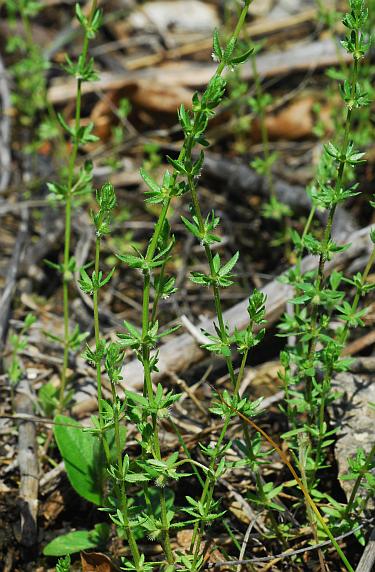Galium virgatum Nutt. ex Torr. & A. Gray
Southwestern Bedstraw

Native
CC = 4
CW = 5
MOC = 41
© SRTurner
Galium virgatum Nutt. ex Torr. & A. GraySouthwestern Bedstraw | |
 |
Native CC = 4 CW = 5 MOC = 41 |
© SRTurner |
|
Family - Rubiaceae Habit - Annual forb. Stems - To 30 cm, ascending to erect, square in cross section, angles with sparse, stiff hairs, faces glabrous.
Leaves - Whorled with 4-5 per node, sometimes appearing more due to additional axillary leaves, leaf whorl usually somewhat asymmetric. Blades sessile, to 7 mm long, narrowly elliptic or lanceolate, pointed at tips, angled at base, with single midvein, undersurface with round to linear impressed glands appearing as dots or lines. Margins entire, flat, ciliate.
Flowers - Borne singly in upper leaf axils, pendent and mostly hidden underneath the leaves, nearly sessile. Calyces minute or absent. Corollas 0.5 mm, 4-lobed, cream colored. Stamens 4, with anthers exserted. Style 2-lobed, with 2 capitate stigmas. Ovary inferior, 2-locular, with 1 ovule per locule.
Fruits - Ovoid to subglobose schizocarps, 2-lobed, about 2 mm in diameter, densely pubescent with hooked hairs.
Flowering - April - June. Habitat - Glades, rocky upland prairies, ledges, bluff tops. Origin - Native to the south-central U.S. Lookalikes - G. pedemontanum. Other info. - This plant is very small and easily missed. Among the Missouri species of Galium, it can often be recognized at a glance by habitat and the asymmetric arrangement of the leaf whorls. The flowers are minute and usually not seen except by close examination. The plant is mostly found in the southern half of the state. Beyond Missouri its range extends to Oklahoma, Arkansas, and Texas, with scattered populations in a few other states. Photographs taken at St. Joe State Park, St. Francois County, MO, 5-13-2016, and at Shaw Nature Reserve, Franklin County, MO, 5-26-2021 (SRTurner). |